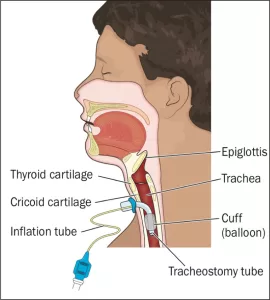
Caring for a tracheostomy is a crucial aspect of ensuring the health and well-being of individuals who have undergone this procedure. A tracheostomy involves creating an opening in the neck to facilitate breathing when the upper airway is compromised. Proper care is essential to prevent complications such as infections, airway obstruction, and other respiratory issues. This guide aims to provide an overview of essential principles and techniques for tracheostomy care, alongside best practices to maintain the health and safety of both the patient and their caregivers.
Understanding Tracheostomy Care: Key Principles and Techniques
Caring for a tracheostomy requires a thorough understanding of the anatomy involved and the specific needs of the patient. The primary objective is to ensure a clear airway and promote optimal respiratory function. It is vital to familiarize oneself with the components of the tracheostomy tube, including the cannula, obturator, and cuff, as well as the indications for each component’s use. Regular assessments of the tracheostomy site are necessary to identify any signs of irritation, infection, or abnormalities that may require medical intervention.
Hygiene is a cornerstone of tracheostomy care. Regular cleaning of the tracheostomy tube and the surrounding skin is essential to minimize the risk of infections. This includes routine suctioning to remove secretions, which helps keep the airway patent and reduces the likelihood of mucus buildup. Caregivers should wear gloves during cleaning procedures and ensure that all equipment is sterile to prevent the introduction of pathogens. It is also important to maintain an optimal humidity level in the air the patient breathes, as dry air can lead to thick secretions and airway blockage.
Education is another critical component of effective tracheostomy care. Patients and caregivers should receive comprehensive training on how to manage the tracheostomy tube, recognize signs of potential complications, and respond appropriately to emergencies, such as accidental decannulation. Establishing a clear communication plan with healthcare providers is essential, ensuring that caregivers feel confident in their skills and knowledge. Regular follow-ups with the healthcare team can reinforce training and provide ongoing support.
Best Practices for Maintaining Tracheostomy Health and Safety
To maintain tracheostomy health, regular monitoring of the tracheostomy site is vital. Caregivers should inspect the area daily for signs of redness, swelling, or discharge, which may indicate an infection. Additionally, assessing the patency of the tracheostomy tube is crucial; any signs of mucus plugging or obstruction should be promptly addressed through suctioning. If the patient experiences difficulty breathing, immediate action must be taken, including ensuring that the tracheostomy tube is properly positioned and functioning.
Another best practice involves developing a routine for changing and cleaning the tracheostomy tube. Most healthcare providers recommend changing the inner cannula at least once a day or as needed, depending on the patient’s secretions. It is also advisable to replace the entire tracheostomy tube on a regular basis, typically every 1-2 weeks, or as directed by a healthcare professional. This routine helps maintain optimal function and reduces the risk of tube-related complications. Caregivers should follow specific guidelines provided by healthcare professionals to ensure that all procedures are performed safely and effectively.
Emergency preparedness is essential for individuals with a tracheostomy. Caregivers should have a plan in place for various scenarios, including accidental decannulation, tube dislodgement, or respiratory distress. This includes keeping an emergency kit readily available, which should contain spare tracheostomy tubes, suction equipment, and instructions for use. Having a clear understanding of when to seek emergency medical help is also crucial. Caregivers should communicate these plans with family members and anyone else involved in the patient’s care to ensure that everyone is prepared to act swiftly and effectively when needed.
Caring for a tracheostomy requires diligence, knowledge, and a proactive approach to prevent complications and ensure the patient’s well-being. Understanding the key principles and techniques involved in tracheostomy care is essential for both patients and caregivers alike. By following best practices and maintaining a strong focus on health and safety, caregivers can significantly enhance the quality of life for individuals with a tracheostomy. Continuous education and open communication with healthcare professionals will further empower caregivers to provide the best possible care, ensuring that the patient remains comfortable and safe.
